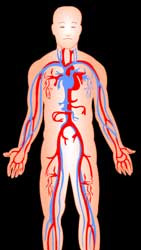 The
cardiovascular or circulatory system is responsible for the movement
of blood throughout the body, with the purpose of delivering oxygen
and nutrients to tissues, disposing waste products from the tissues
plus carrying hormones as cellular signals. The
cardiovascular or circulatory system is responsible for the movement
of blood throughout the body, with the purpose of delivering oxygen
and nutrients to tissues, disposing waste products from the tissues
plus carrying hormones as cellular signals.
It consists of a pump (the heart) and an
extensive network of channels (the arteries, capillaries and veins).
The arteries carry blood away from the heart; the capillaries allow
for exchange of material between the blood and the tissues; the
veins return the blood to the heart.
In addition to blood vessels, a
second network of channels, the lymphatic vessels, will also be
studied in this exercise. These vessels carry lymph
(intercellular fluid) which is filtered through lymph nodes and
eventually returned back to the blood.
Learning Objectives:
- To understand the overall
organization and histological features of the heart and major
blood vessels.
- To recognize the histological
features that distinguish arteries from veins.
- To recognize arterioles,
capillaries and venules in LM preparations and understand how
their structures relate to their functions.
- To be able to recognize
lymphatic vessels
Let's first look at
the heart. |